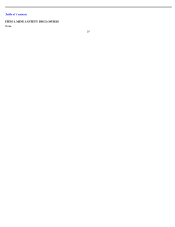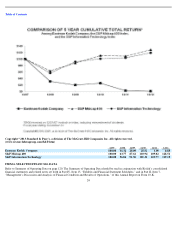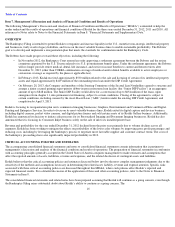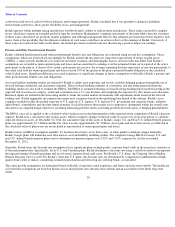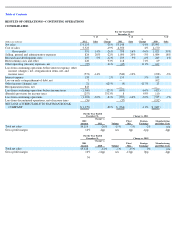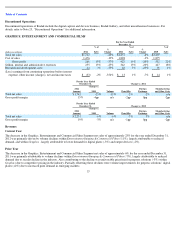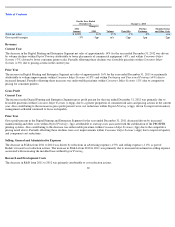Kodak 2012 Annual Report Download - page 32
Download and view the complete annual report
Please find page 32 of the 2012 Kodak annual report below. You can navigate through the pages in the report by either clicking on the pages listed below, or by using the keyword search tool below to find specific information within the annual report.
Table of Contents
as the forecasted uses of cash for both its domestic and foreign operations, Kodak concluded that it was prudent to change its indefinite
reinvestment assertion to allow greater flexibility in its cash management.
Kodak operates within multiple taxing jurisdictions worldwide and is subject to audit in these jurisdictions. These audits can involve complex
issues, which may require an extended period of time for resolution. Management’s ongoing assessments of the more-likely-than-not outcomes
of these issues and related tax positions require judgment, and although management believes that adequate provisions have been made for such
issues, there is the possibility that the ultimate resolution of such issues could have an adverse effect on the earnings of Kodak. Conversely, if
these issues are resolved favorably in the future, the related provisions would be reduced, thus having a positive impact on earnings.
Pension and Other Postretirement Benefits
Kodak’s defined benefit pension and other postretirement benefit costs and obligations are estimated using several key assumptions. These
assumptions, which are reviewed at least annually by Kodak, include the discount rate, long-term expected rate of return on plan assets
(“EROA”), salary growth, healthcare cost trend rate and other economic and demographic factors. Actual results that differ from Kodak’s
assumptions are recorded as unrecognized gains and losses and are amortized to earnings over the estimated future service period of the active
participants in the plan or, if almost all of a plan’
s participants are inactive, the average remaining lifetime expectancy of inactive participants, to
the extent such total net unrecognized gains and losses exceed 10% of the greater of the plan’s projected benefit obligation or the calculated
value of plan assets. Significant differences in actual experience or significant changes in future assumptions would affect Kodak’s pension and
other postretirement benefit costs and obligations.
Asset and liability modeling studies are utilized by Kodak to adjust asset exposures and review a liability hedging program through the use of
forward looking correlation, risk and return estimates. Those forward looking estimates of correlation, risk and return generated from the
modeling studies are also used to estimate the EROA. The EROA is estimated utilizing a forward-looking building block model factoring in the
expected risk of each asset category, return and correlation over a 5-7 year horizon, and weighting the exposures by the current asset allocation.
Historical inputs are utilized in the forecasting model to frame the current market environment with adjustments made based on the forward
looking view. Kodak aggregates investments into major asset categories based on the underlying benchmark of the strategy. Kodak’s asset
categories include broadly diversified exposure to U.S. and non-U.S. equities, U.S. and non-U.S. government and corporate bonds, inflation-
linked bonds, commodities and absolute return strategies. Each allocation to these major asset categories is determined within the overall asset
allocation to accomplish unique objectives, including enhancing portfolio return, providing portfolio diversification, or hedging plan liabilities.
The EROA, once set, is applied to the calculated value of plan assets in the determination of the expected return component of Kodak’s pension
expense. Kodak uses a calculated value of plan assets, which recognizes changes in the fair value of assets over a four-year period, to calculate
expected return on assets. At December 31, 2012, the calculated value of the assets of Kodak’s major U.S. and Non-
U.S. defined benefit pension
plans was approximately $7.3 billion and the fair value was also approximately $7.3 billion. Asset gains and losses that are not yet reflected in
the calculated value of plan assets are not included in amortization of unrecognized gains and losses.
Kodak reviews its EROA assumption annually. To facilitate this review, every three years, or when market conditions change materially,
Kodak’s larger plans will undertake asset allocation or asset and liability modeling studies. The weighted average EROA for major U.S. and
non-U.S. defined benefit pension plans used to determine net pension expense was 8.52% and 7.02%, respectively, for the year ended
December 31, 2012.
Generally, Kodak bases the discount rate assumption for its significant plans on high quality corporate bond yields in the respective countries as
of the measurement date. Specifically, for its U.S. and Canadian plans, Kodak determines a discount rate using a cash flow model to incorporate
the expected timing of benefit payments and an AA-rated corporate bond yield curve. For Kodak’s U.S. plans, the Citigroup Above Median
Pension Discount Curve is used. For Kodak’s other non-U.S. plans, the discount rates are determined by comparison to published local high
quality bond yields or indices considering estimated plan duration and removing any outlying bonds, as warranted.
The salary growth assumptions are determined based on Kodak’s long-term actual experience and future and near-term outlook. The healthcare
cost trend rate assumptions are based on historical cost and payment data, the near-term outlook and an assessment of the likely long-term
trends.
29


